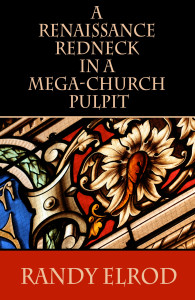 Writing my memoir, A Renaissance Redneck In A Mega-Church Pulpit (releases on Amazon Feb. 5) over the past year has proven a tremendous exercise in self-discovery. William Zinsser in his classic guide to writing non-fiction, On Writing Well, says that, “Ultimately the product that any writer has to sell is not the subject being written about, but who he or she is.”
Writing my memoir, A Renaissance Redneck In A Mega-Church Pulpit (releases on Amazon Feb. 5) over the past year has proven a tremendous exercise in self-discovery. William Zinsser in his classic guide to writing non-fiction, On Writing Well, says that, “Ultimately the product that any writer has to sell is not the subject being written about, but who he or she is.”
Four invaluable lessons I’ve learned:
1.) Real is good. Interesting is better. (Stanley Kubrick) We all have stories about our life that we would like to tell, but finding those that are “interesting”—that touch the universal fabric of humanity—now that is the challenge. It takes work to find the tales in our lives that are as old as time. Our best stories are personal, candid, and deeply felt.
2.) The first condition of progress is the removal of censorship. (George Bernard Shaw) I found this a constant battle throughout the writing process. When Pat Conroy wrote The Great Santini, his mother and her devoutly religious relatives were horrified by his retelling of their family’s secrets. They wanted nothing more to do with him. Pat himself had to enter therapy once the book appeared, and he described the reaction by his family to his novel as “a collective nervous breakdown.”
Writing about others who have hurt you is also difficult. Anne Lamott says, “Own everything that happened to you. Tell your stories. If people wanted you to write warmly about them, they should have behaved better.”
3.) Good story should have four layers of meaning. (Dante Alighieri) Dante’s 4 levels of interpretation influenced my memoir. They are much the same as the Mediaeval Levels of Allegorical Interpretation:
1. Literal / Historical
2. Allegorical / Spiritual
3. Tropological / Moral
4. Anagogical / Mystical
My favorite writer Ayn Rand once said she attempted to include Dante’s four levels in every paragraph of her magnum opus Atlas Shrugged. I cannot comprehend this. I struggled to include the four levels in every chapter, and that task required monumental effort.
4.) The creative process can be a pathway to the true self. (James Masterson, M.D.) The birthright of the real self is creativity; the ability to invent, to perceive old patterns in new relationships, or to rearrange old patterns in new ways. Everyone with a healthy real self (or what I refer to as consciousness throughout my memoir,) has the potential for leading a creative life and dealing with problems and challenges in innovative ways. Not all individuals have the same capacity for expressing their creativity, of course, since it, like all other capacities, is a product of nature and nurture, of genetic inheritance and developmental encouragement.
5.) Flawed work is better than none at all. (William Faulkner) Perfectionism is our greatest enemy. We must find the courage to one day say, “It is finished. It’s not perfect, but if it were I would have no more reason to write…to live.”
Leave a Reply